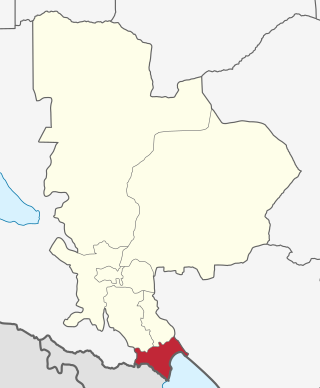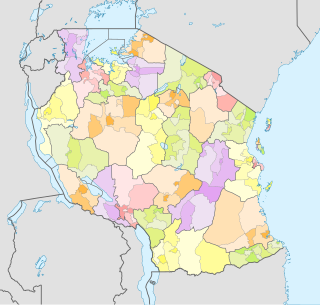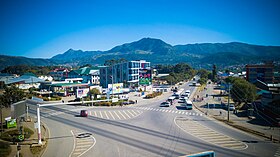
Mbeya Region is one of Tanzania's 31 administrative regions. The region covers an area of 35,954 km2 (13,882 sq mi). The region is comparable in size to the combined land area of the nation state of Guinea Bissau. Mbeya Region is bordered to the east by Singida Region, Iringa Region and Njombe Region. The region is bordered to the south by Malawi and Lake Nyasa. To the north the region borders southern Tabora Region. Lastly, Mbeya is bordered to the west by Songwe Region. The regional capital is the city of Mbeya. According to the 2022 national census, the region had a population of 2,343,754.
The Kipengere Range, also known as the Livingstone Mountains, lies entirely in Njombe Region in southwest Tanzania at the northern end of Lake Nyasa. Near Lake Nyasa they are known as the Kinga Mountains. It is a plateau-like ridge of mountains running southeastwards from the basin of the Great Ruaha River in the north to that of the Ruhuhu River in the south, and forms part of the eastern escarpment of the East African Rift. The range is mostly clad in montane grasslands, renowned for their botanical diversity and displays of flowers, with montane evergreen forests mostly in stream valleys.

Chunya District is one of the seven districts of Mbeya Region, Tanzania. It is bordered to the north by Tabora Region, to the northeast by Singida Region, to the east by Mbarali District, to the south by Mbeya Rural District, and to the west by Songwe District.

Mbarali District is one of the five districts of Mbeya Region, Tanzania. It is bordered to the north by Iringa region and east by Njombe region. To the south the district is bordered by Mbeya District and to the west by Chunya District.

Mbeya Rural District is one of the seven districts of Mbeya Region, Tanzania. It is bordered to the north by Mbarali District and Chunya District, to the south by Mbeya Urban District and Rungwe District, to the east by Iringa Region and to the west by Mbozi District.

Kyela is one of the seven districts of Mbeya Region, Tanzania. It is bordered to the north by Rungwe District, to the northeast by Njombe Region, to the southeast by Lake Nyasa, to the south by Malawi and to the west by Ileje District.

As of 2021, there are 31 regions of Tanzania which are divided into 184 districts.

Tukuyu, known as Neu Langenburg during the German's colonial rule, is a hillside town that lies about 36 miles (58 km) south of the city of Mbeya, at an elevation of around 5,000 ft (1,500 m) in the highland Rungwe District of southern Tanzania, East Africa. Tukuyu has a moderate to cool temperature ranging from 10 °C in May and June to mid 20 °C in around November. The town and the surrounding areas are green all year round due to the almost year-round convectional rains resulting from Lake Nyasa. Tukuyu is divided into several wards include; Kawetere, Msasani, Bulyaga and Bagamoyo.

Lake Ngozi(or Lake Ngosi) is the second largest crater lake in Africa. It can be found near Tukuyu, a small town in the highland Rungwe District, Mbeya Region, of southern Tanzania in East Africa. It is part of the Poroto Mountains and the northern rim of the caldera is the highest point in the range. The caldera mostly composed from trachytic and phonolitic lavas. Ngozi is a Holocene caldera that generated the Kitulo pumice 12,000 years ago during a Plinian eruption, most likely in the same eruption that generated the caldera. Other eruption deposits are the Ngozi Tuff (less than thousand years ago) and the Ituwa Surge base surge deposits of uncertain age, but intermediary to the Kitulo pumice and Ngozi Tuff. The youngest activity generated a pyroclastic flow that flowed southwards for 10 km around 1450 CE. Some pyroclastic cones surround the volcano. The walls of the caldera are forested, with the exception of segments scoured by landslides and high cliffs that inhibit access to the water. The inner caldera is forested with Maesa lanceolata, Albizia gummifera and Hagenia abyssinica, far fewer tree species than neighbouring mountains consistent with the recent geological origin of the volcano. The caldera itself is not subjected to hydrothermal activity, but large subaqueous CO2 emissions and local legends of the killing power of the lake indicate a danger of limnic eruptions. The lake floor according to echosounding is flat and has no terraces.
Kinyala is an administrative ward in the Rungwe District of the Mbeya Region of Tanzania. In 2016 the Tanzania National Bureau of Statistics report there were 14,185 people in the ward, from 12,871 in 2012.
Bonde la Usongwe, is a administrative ward in Mbeya Rural in the Mbeya Region of Tanzania. The ward covers an area of 103.1 square kilometres (39.8 sq mi) with an average elevation of 1,431 metres (4,695 ft).

Kitulo National Park is a protected area of montane grassland and montane forest on the Kitulo Plateau in the southern highlands of Tanzania. The park is at an elevation of 2,600 metres (8,500 ft) between the peaks of the Kipengere and Poroto mountains and covers an area of 412.9 square kilometres (159.4 sq mi), lying in Mbeya Region and Njombe Region. The park is administered by Tanzania National Parks (TANAPA) and is the first national park in tropical Africa to be established primarily to protect its flora.
The Southern Highlands is a highland region in southwestern Tanzania, at the northern end of Lake Malawi. The highlands include portions of Mbeya, Njombe, Rukwa, Ruvuma, and Songwe regions, bordering Malawi, Mozambique, and Zambia. Mbeya is the largest city in the highlands.
Mbeya Range is a volcanic mountain range in Mbeya Region, in southwestern Tanzania, East Africa. It forms an arc just north of the town of Mbeya and includes Loleza Peak, Mbeya Peak, Nyanuwa Peak, and Pungulumo. The range is at the junction of the eastern Gregory Rift and western Albertine Rift valleys. and is in Rungwe volcanic province. The Songwe Scarp terminates the Rukwa Trough at its southeast end and forms the northwestern side of the Mbeya Range.

Katavi Region is one of Tanzania's 31 administrative regions. The region covers an area of 45,843 km2 (17,700 sq mi). The region is comparable in size to the combined land area of the nation state of Estonia. Katavi Region is bordered to the east by Tabora Region, and to the south by Rukwa Region and Songwe Region. Lastly, Katavi borders DRC on Lake Tanganyika to the west. The region derives its name from Katavi, the spirit of lake Tanganyika. The regional capital city is Mpanda. According to the 2022 national census, the region had a population of 1,152,958.

Tulia Ackson is the Speaker of the National Assembly of Tanzania, in office since 2022. She was appointed as a Member of Parliament by President John Magufuli. On 27 October 2023, she was elected the President of the Inter-Parliamentary Union (IPU) through the meeting convened at Luanda Angola where she passed other contestants by a great margin.

The Tanzam Highway leads from Lusaka in Zambia to Dar es Salaam in Tanzania. The highway was built from 1968 to 1973 in several stages and was intended to provide seaport access for Zambia and to expand the transport options for Zambia, Malawi and the then Zaire.
The Umalila Mountains are a mountain range in southern Tanzania, on the border with Malawi. The Umalila Mountains are part of Tanzania's Southern Highlands.
The Rungwe dwarf galago is a newly identified species of eastern dwarf galago. Specimens were first collected in the 1930s, but were identified as different species. A formal description of the species is presently being made.



























